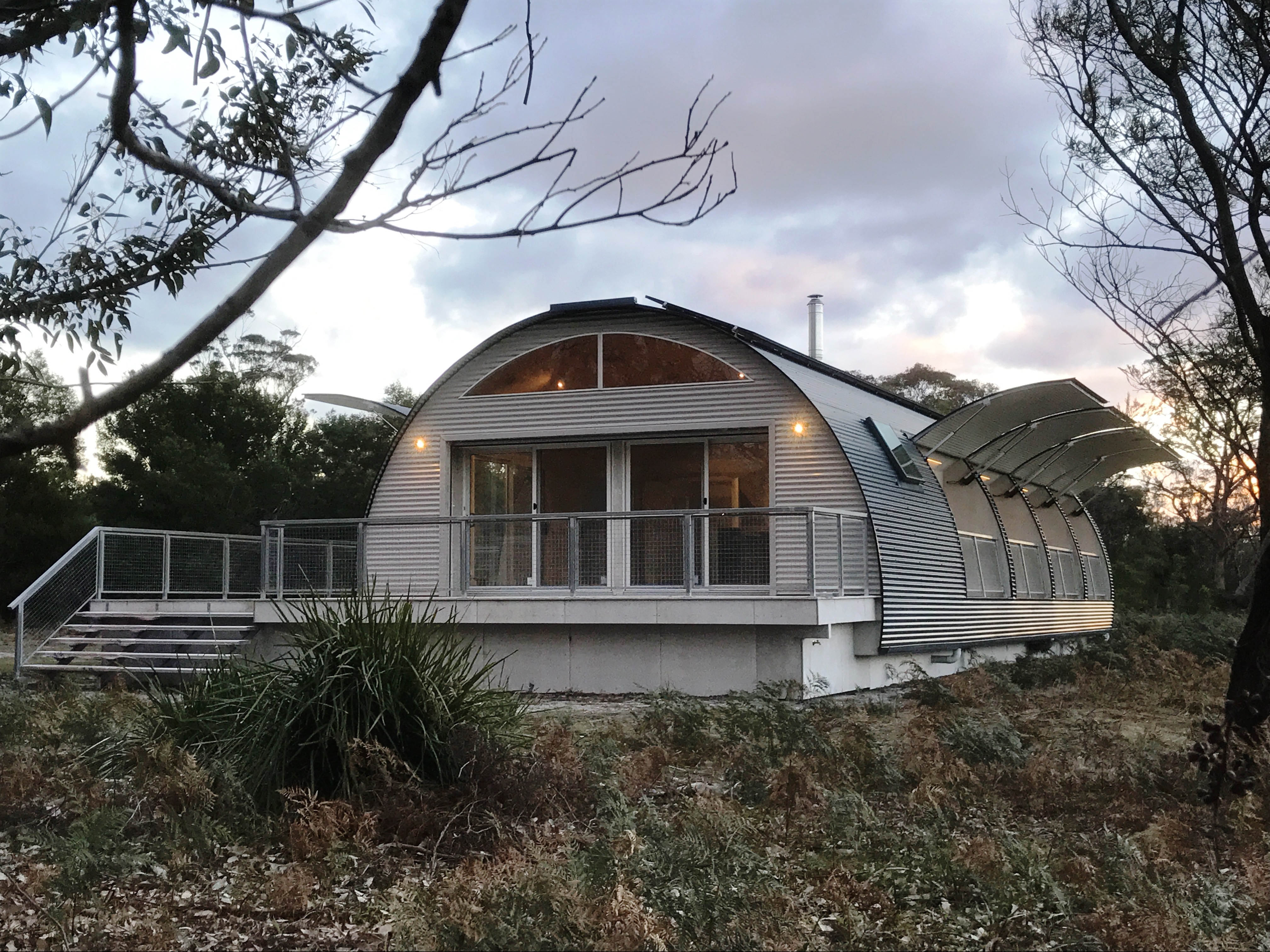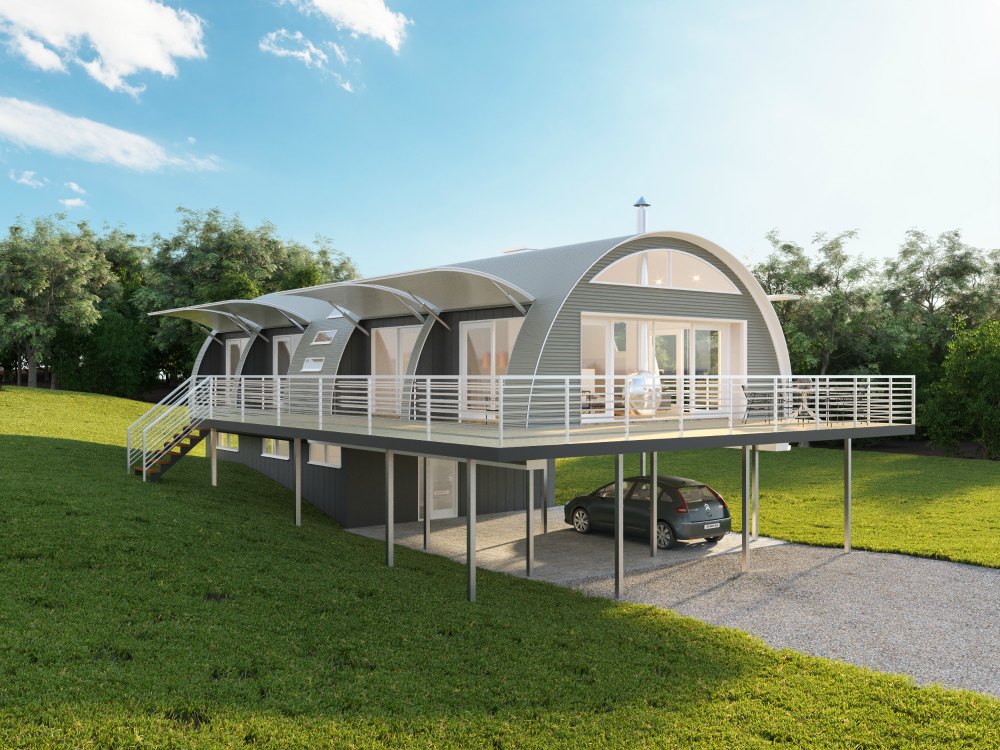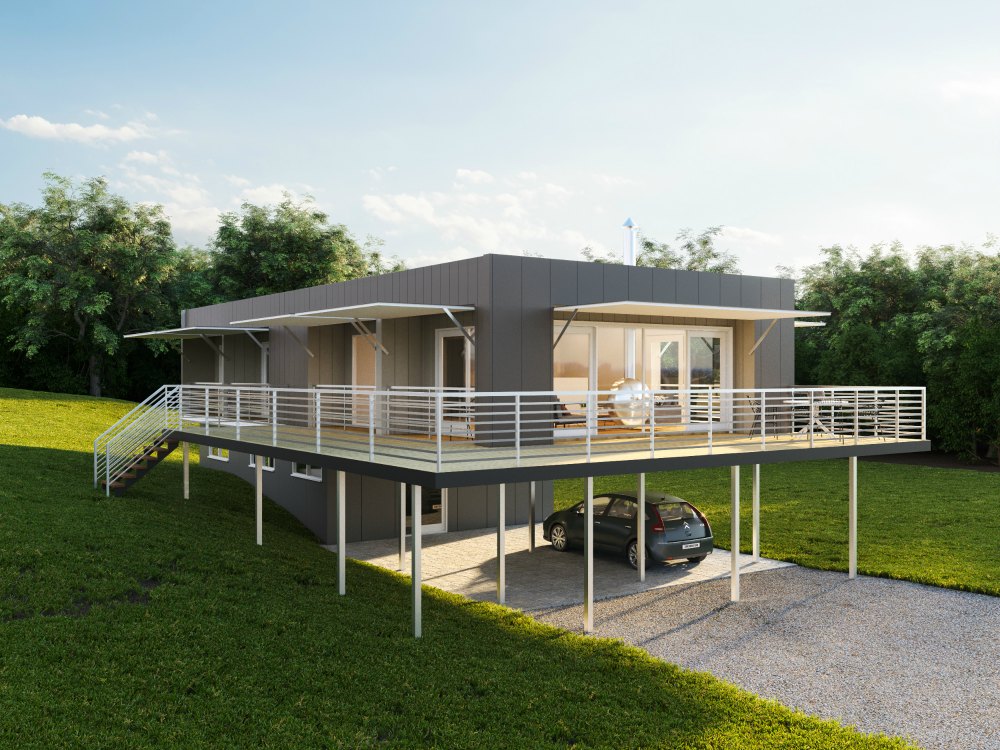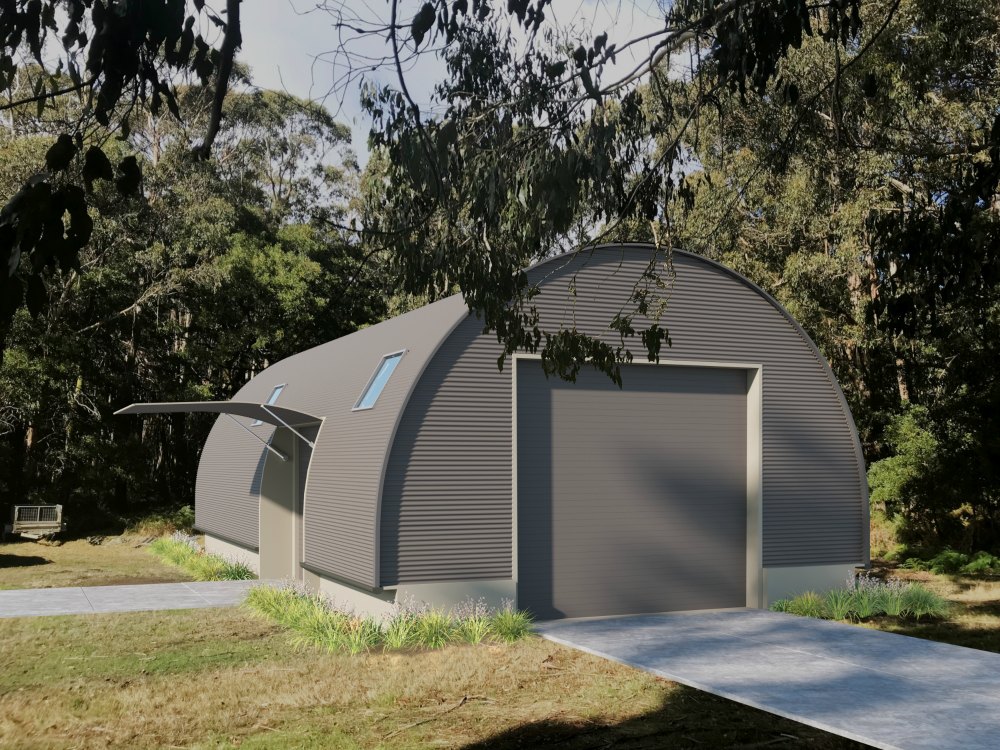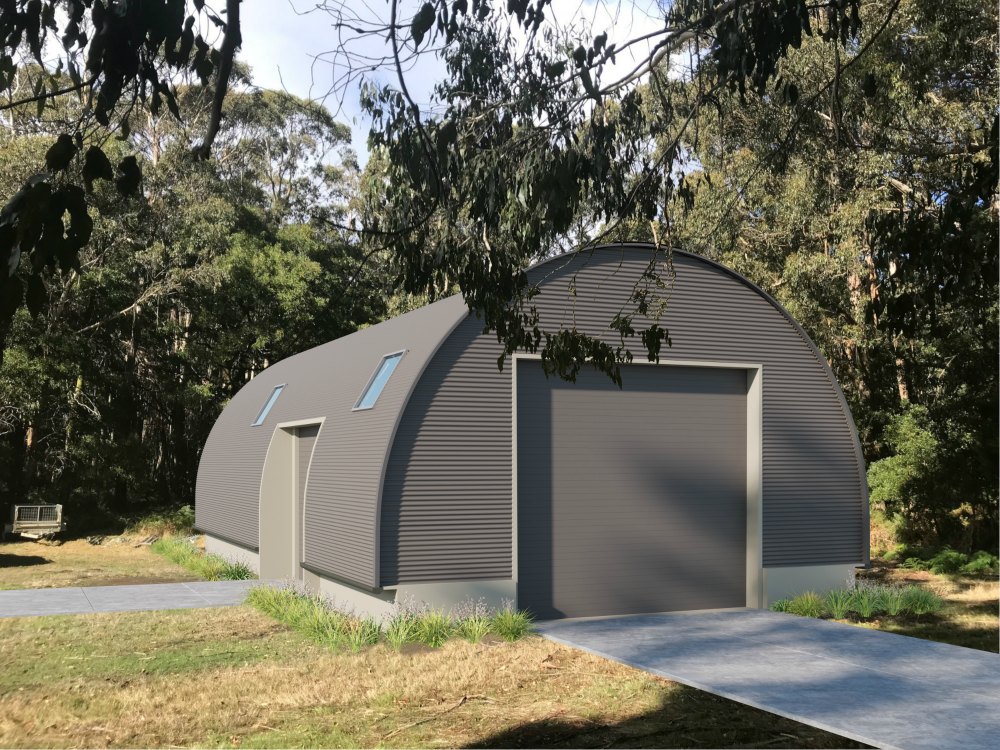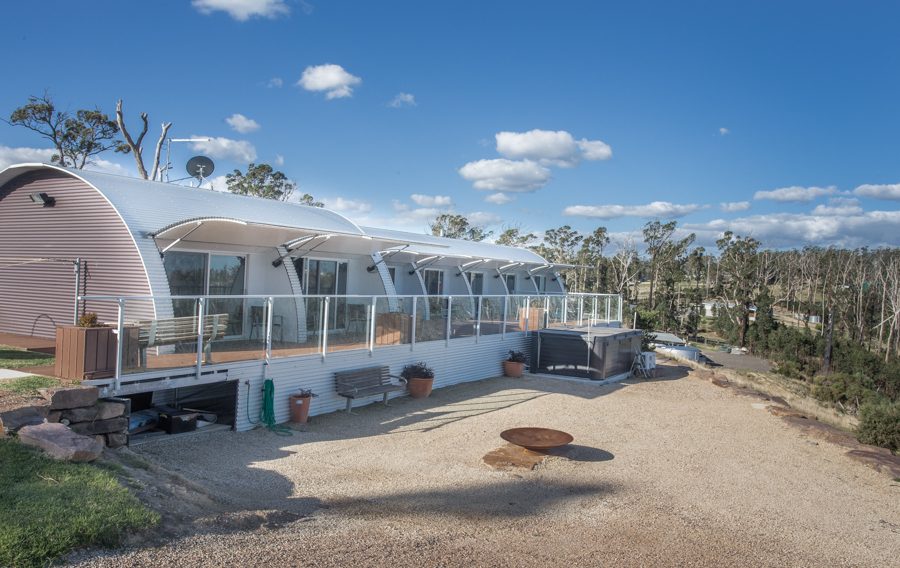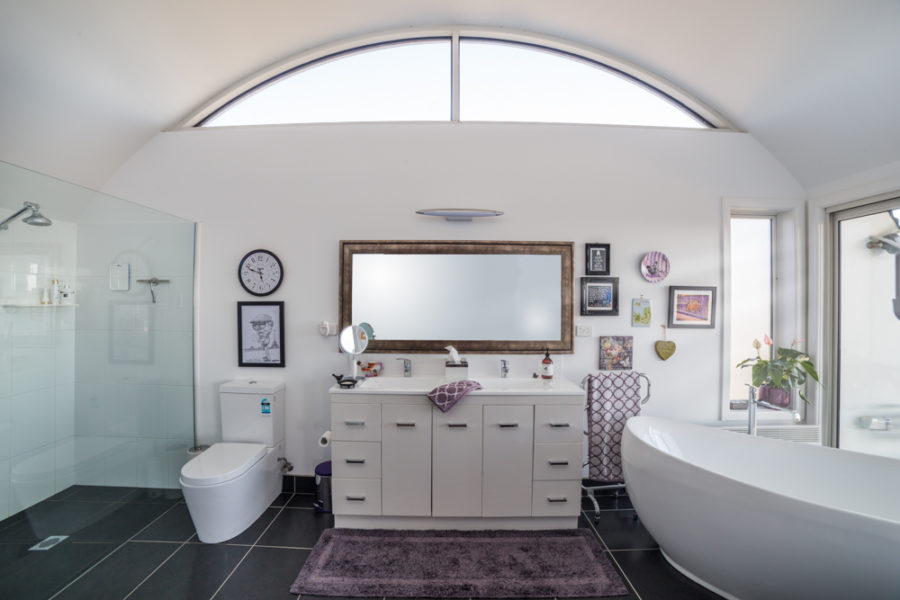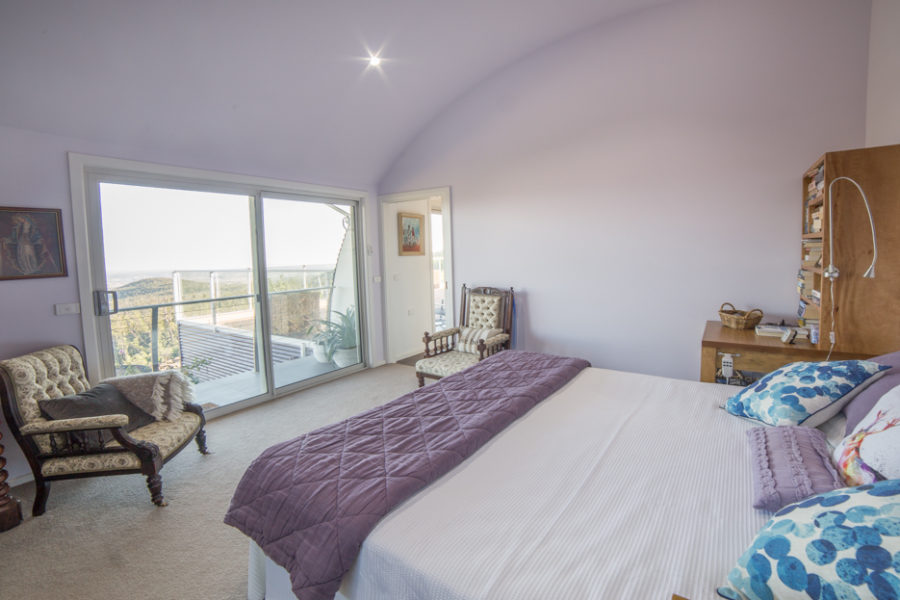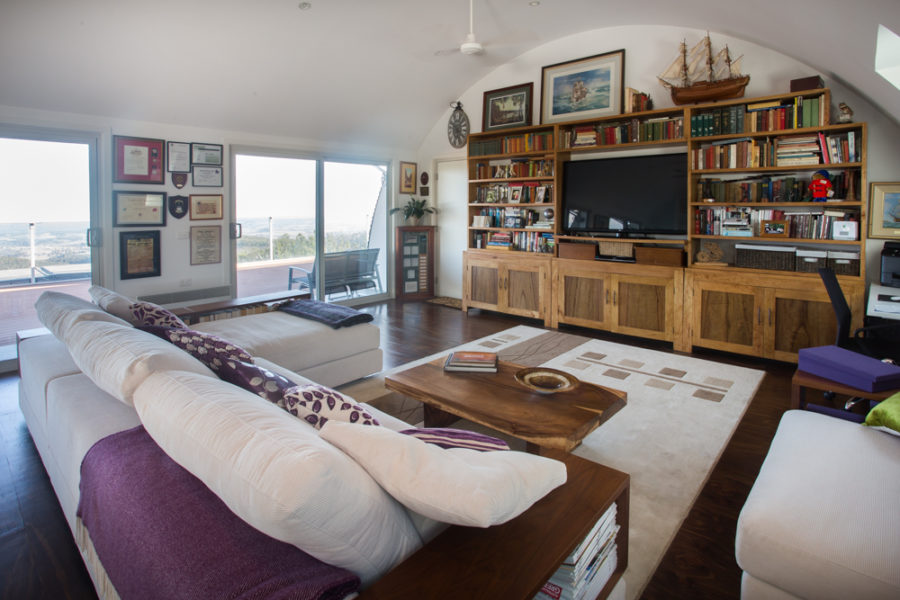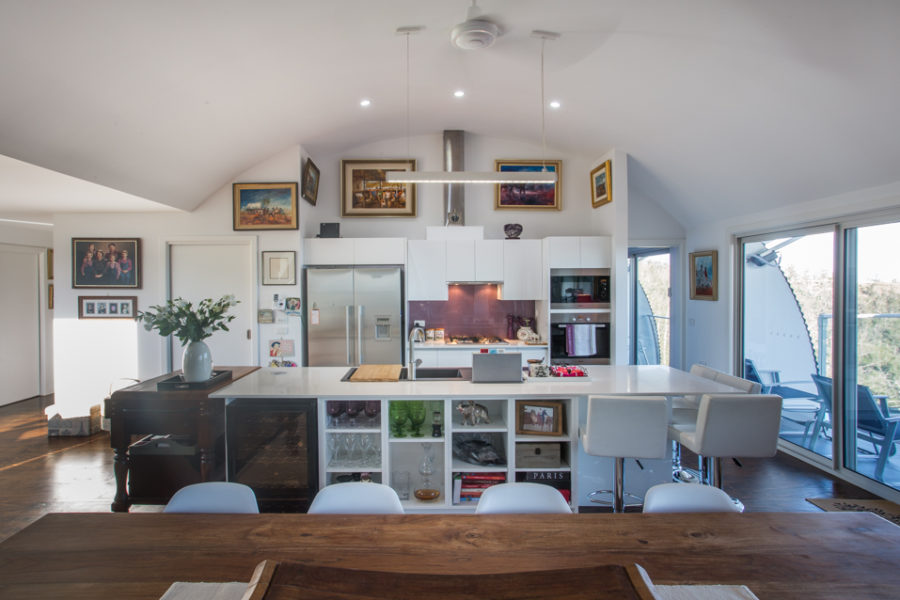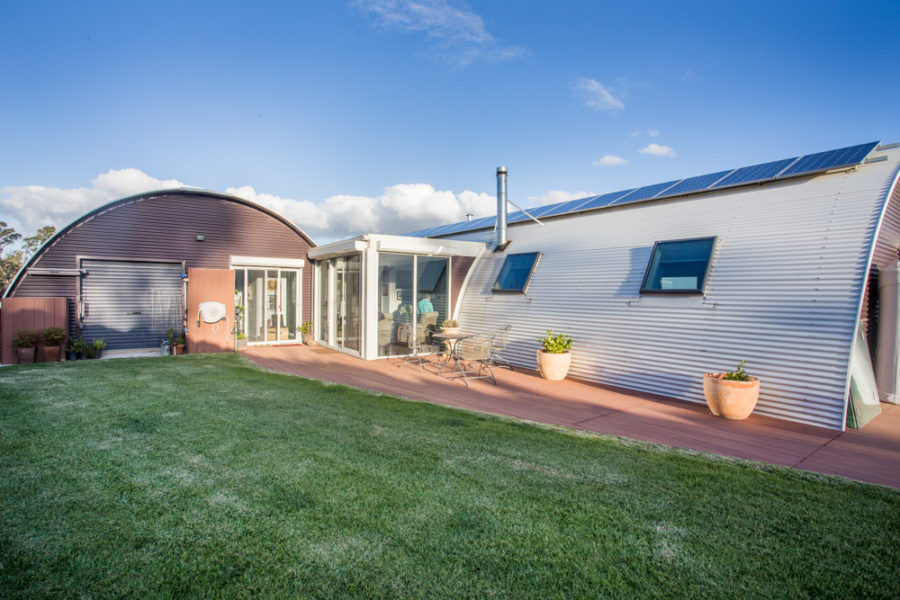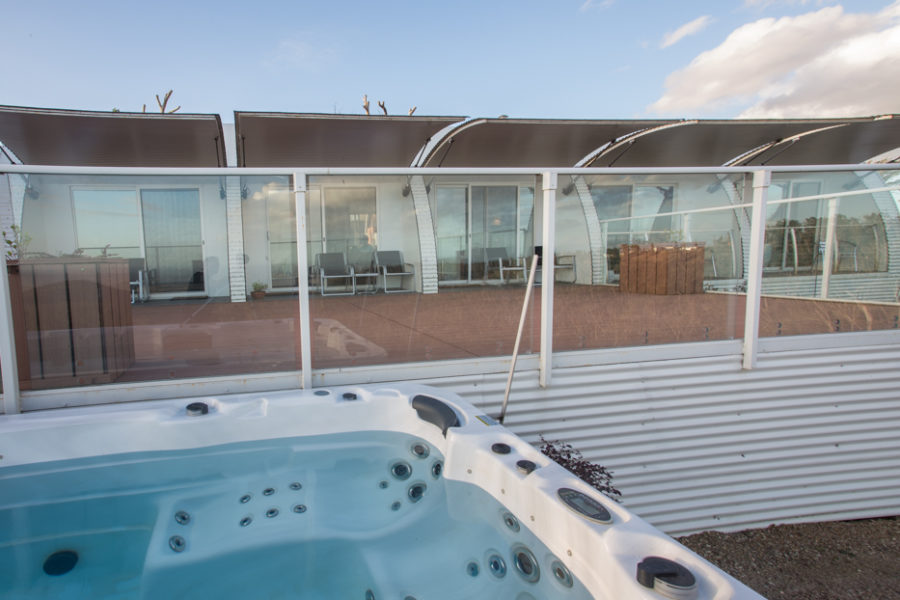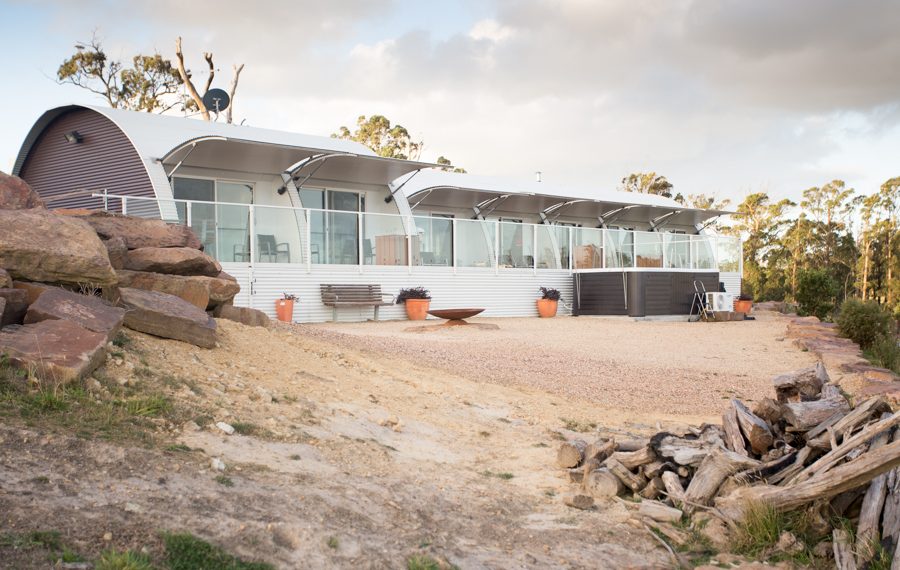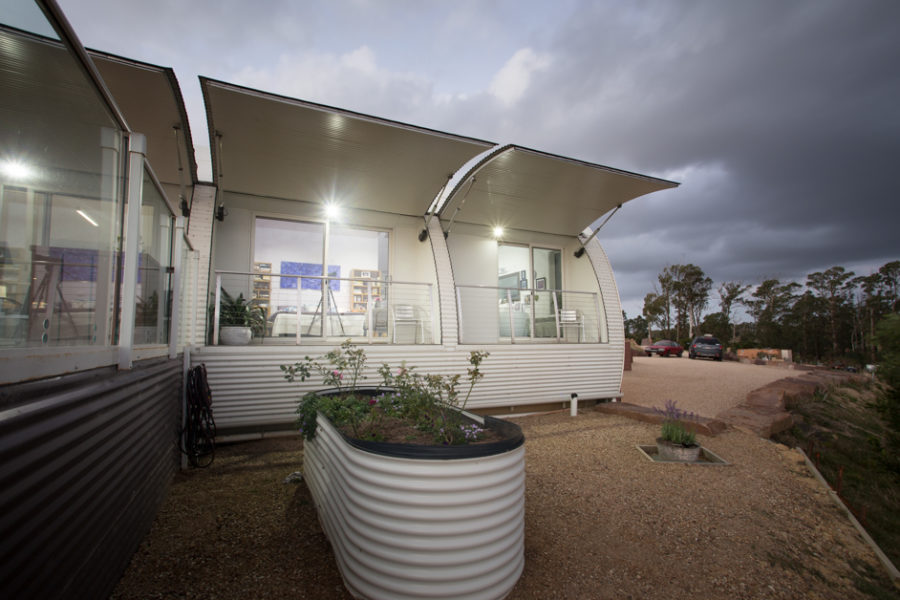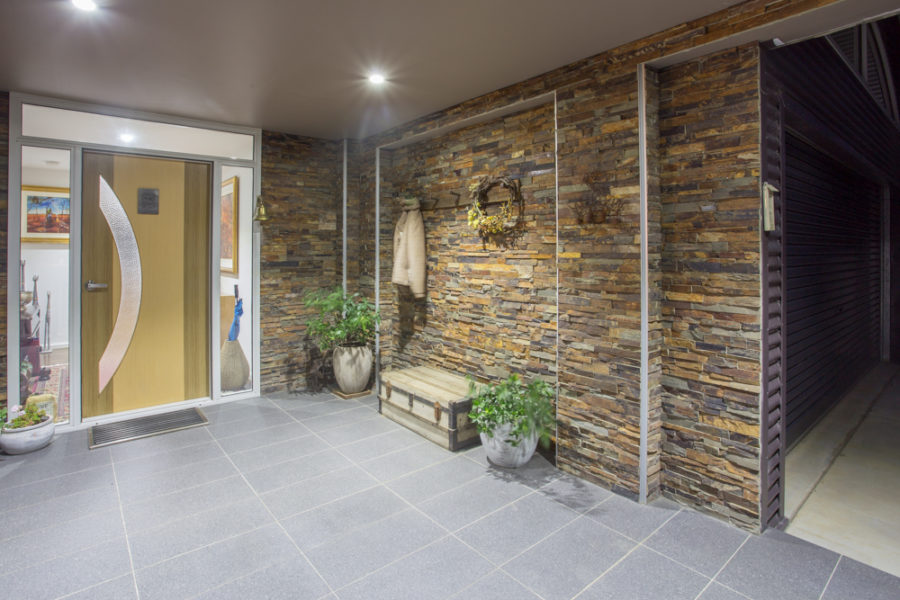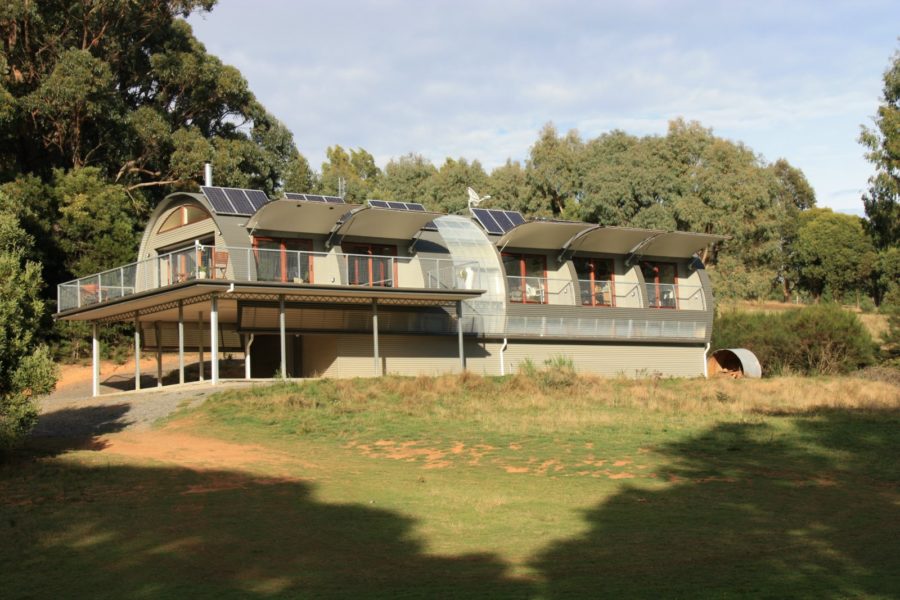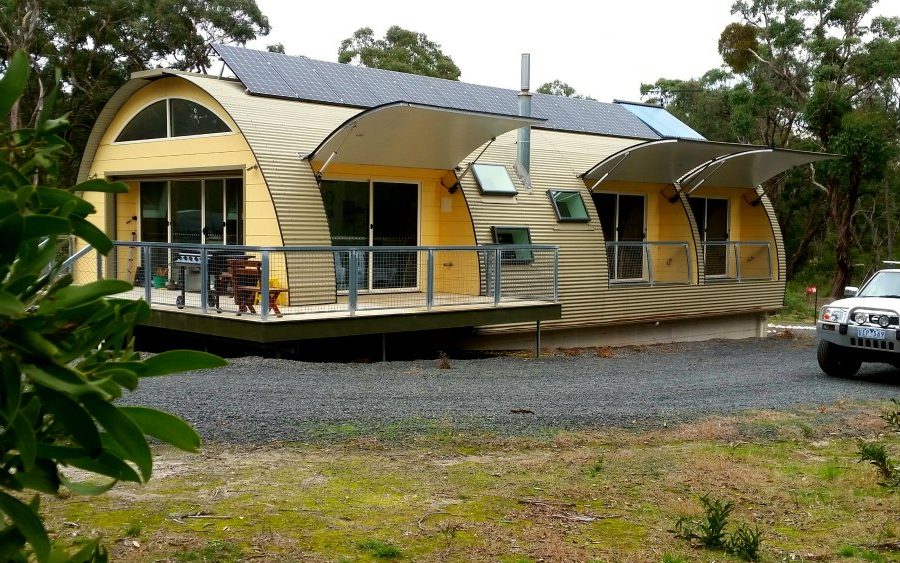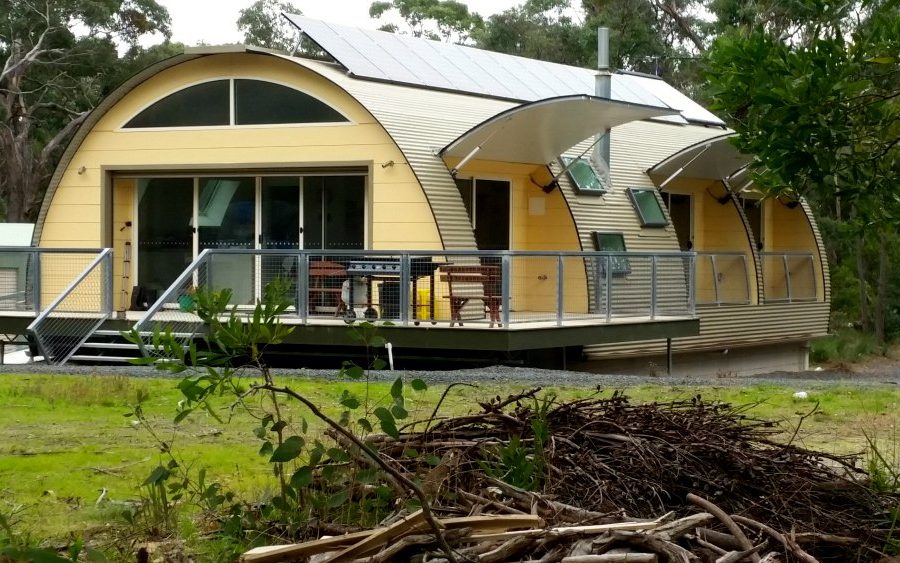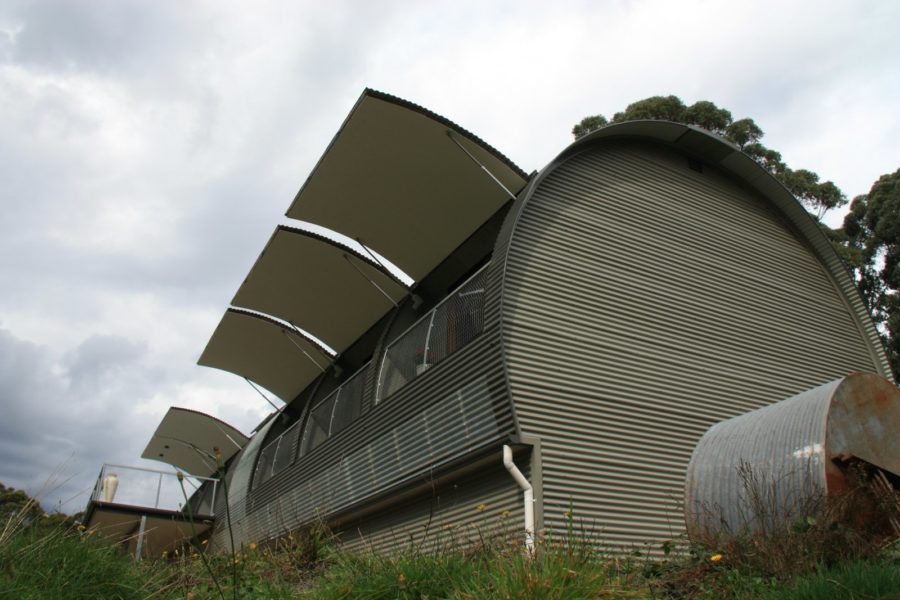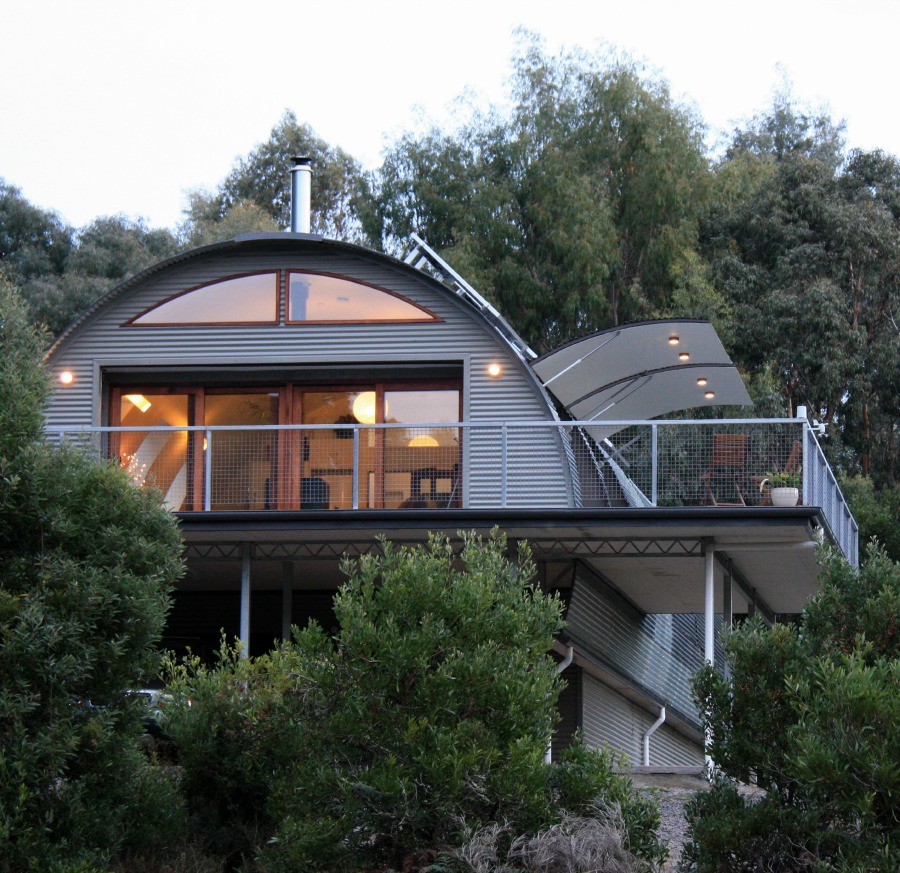Flexible Design
The Convertible Home layout is readily adaptable to suit individual requirements. Internal walls are non – loadbearing, effectively partitions meaning they can be relocated if and when required to suit the occupant’s changing lifestyle. No expensive engineering or structural modifications are required. The superstructure is made from lightweight high tensile open web steel framing, it can be readily adapted for a variety of both permanent and non-permanent structures, including small homes, sheds, holiday homes and permanent homes.
Bushfire and Storm Resistant
The aerodynamic curvilinear shape, material selection and bespoke operable awnings combine to achieve a secure, bushfire and storm resistant structure achieving BAL40+ as standard construction.
Affordable Innovation
Off-site accurate semi-prefabrication means precise, faster on-site construction and less wastage. This methodology equates to more cost effective, robust construction. The active technologies incorporated in the Convertible Home have been tried and tested over several builds.
Sustainable Design & Construction
The Convertible Home employs modular construction principles working to standardized material sizes where possible. Excellent Energy Ratings are achieved through site responsive design and orientation combined with other well considered elements such as insulation, window sizing and glazing selection. The expansive roof / wall areas are very effective at harvesting rain for potable use. Various grey and black water treatment systems have been incorporated in our Convertible Home builds. Designology will source the most appropriate building systems and products for your needs in compliance with local authority requirements.
More features of the Convertible Home
Convertible Home Applications
Detached Dwellings
Convertible Homes are suitable as your primary residence and for many other applications i.e. Small / Tiny Homes / Pods, Cabins, Holiday Homes, etc. They can be designed as either a single or double storey version customised to suit your individual requirement’s. Due to the unique pole platform footing system even the most topographically challenging sites can be accommodated.
Having excellent bushfire resistant construction (meeting BAL 40 +) making it an ideal solution for bushfire prone zones.
Tiny Homes
If you want to experience living in a tiny home, you can with our one-bay, or POD, designed Convertible Home. A sustainable and affordable option.
Holiday Homes
Convertible Homes also make the perfect weekender or holiday retreat ideally suited for rural and coastal locations. The construction is very cost competitive against other prefabricated options on the market however being highly bushfire and storm resistant, secure and durable gives it even greater appeal. The operable awnings / shutters allow the building to be locked down increasing the general security providing protection from intruders and extreme weather events whilst you’re away.
Holiday Cabins
‘Lightly Touching The Landscape’ Convertible Homes are an ideal solution for holiday cabins. Using a light gauge pile footing system rather than mass concrete pad footings means no footing excavations required, no open holes, no pumping water from excavations, minimal spoil, no concrete pumps and no concrete truck access issues. Cabins can be relocated or removed from site if required.
Commercial
The structure can be easily adapted for a variety of both permanent and non-permanent structures.
The innovative design and lightweight modular construction makes the Convertible Home an ideal alternative for commercial applications such as temporary event sheds, multiple dwellings for holiday park developments, mining accommodation, communal and retirement villages.
Convertible Sheds
We’re presently refining the design and construction of our unique Convertible Shed. This will provide a significantly higher level of security from bushfire and storm than traditionally constructed sheds. We’re hoping to commence building the prototype early in 2018…we will keep you posted!
Alternative applications
Using architectural tensile membrane roofing systems in lieu of traditional roof / wall cladding the structure could also be used where emergency shelter is required and for remote and environmentally sensitive areas such as National Parks. The structure can be relocated or dismantled and re-erected as required.
Assembly
The semi-prefabricated construction system is relatively simple to erect and extend. Design features include:
- Strong, light and durable materials able to be cost effectively freighted are considered a critical component of the design.
- The modular nature of the construction, using primarily lightweight materials, assists in simplifying sourcing and delivery of materials.
- One of the main features of the Convertible Building is the unique, lightweight and versatile modular portal frame design and connection details which simplify and speed up the erection process.
Designology’s unique hinged portal frame connections allow the roof / wall structure to be safely assembled and clad at ground level then erected with lifting equipment. This reduces OH&S issues associated with working at heights and scaffolding requirements
Sustainability
The building materials specified have been carefully considered and selected using the following criteria:
- Inherent durability
- Potential for recycling
- Serviceability
- Embodied energy
- Aesthetics
- Ease of transportation
- Overall cost effectiveness
As an example, steel Colourbond CGI (corrugated iron) roof and wall cladding has been specified for its inherent properties, i.e. durability, low thermal mass, low maintenance, bushfire and storm resistance and economics. It’s also ideal for rain harvesting and provides an appropriate architectural response for both rural and coastal locations.
Plywood was the world’s first engineered timber product and is frequently specified for the ceiling and wall linings whilst also assisting with bracing the structure. Plywood is produced from renewable and sustainable plantation resource timber, is economical and has an environmentally friendly manufacturing process using resource landscaping materials (bark and log cores). Other inherent qualities including low toxicity, low embodied energy, low thermal mass, high uniform strength and low shrinkage, versatility, lightweight and impact resistance make it an appropriate choice.
The main superstructure has been designed using lightweight high tensile steel framing. Although steel has relatively high embodied energy compared to timber, unlike timber it’s infinitely recyclable. Steel has been selected for its superior strength to weight properties, durability, stability and versatility. All of the framing components can be pre-cut and/or pre-fabricated to the required shape and lengths thereby eliminating the need for additional cutting on site and wastage. Most of the members can be quickly and easily assembled using tek screws or bolted connections.
Internal walls are non-load bearing and can therefore be constructed using a variety of lightweight materials e.g. timber or steel stud framing.
Solar
Where possible we always orientate our Convertible Homes to maximise exposure to northern solar access. High performance double glazed windows and sliding doors are specified and positioned in all north facing habitable rooms providing excellent natural light and maximising solar gain.
Where specified the solar conservatory (optional item) over the stairwell /entry area acts as a heat bank (solar collector) during the day in winter by maximising solar gain. This warm air is trapped, filtered and redistributed to other rooms using heat recovery ventilation.
The combined free and environmentally friendly passive heating from the solar collector, radiant heat and thermal mass reduce the sole reliance on alternative heating sources e.g. solid fuel heaters, wall furnaces, split air-conditioners.
In summer, the solar conservatory / collector (optional item) over the stairwell acts as a thermal chimney drawing in cooler air from lower level operable screened vents and expelling it through the heat recovery ventilation system and static ridge vents located at both ends of the building. This thermo suction effect is also employed in other areas of the house to assist with cooling and ventilation. Openable roof windows / skylights can be additionally located along the ridge line to expel warm stale air in the warmer months. Good cross flow ventilation is achieved in the main living areas by using openable south facing roof windows which can be further enhanced by locating openable smaller south facing roof windows / skylights in the utility areas.
Once the external superstructure is completed, it also acts as a thermal chimney. As the outer corrugated skin/cladding heats up on the upper surface, cooler air is naturally “syphoned” from outside through fixed or operable low level eave vents which in turn forces the warmer stale air up the roof / wall cavity, it’s then purged through static ridge vents.
Grid interactive or remote area solar power systems can be readily incorporated into the Convertible Home. Solar panels can be installed directly onto the corrugated roof / wall cladding at the required height and angle to maximise solar performance. Inverters and battery banks can be installed in a dedicated space at ground level or in the sub-floor area.
Water Management
Self composting toilets, Smart flush toilets, effluent treatment systems, potable water storage solutions are considered as part of the overall design and selected specifically for every location.
On single storey Convertible Homes potable water is collected from the expansive roof/wall area and gravity fed into an above ground bladder tank (approx. 8,000 – 10,000 litres) located in the sub-floor area. Additional above ground higher capacity tanks can be located elsewhere for stock and / or bushfire fighting purposes. Rain harvesting is maximised via the barrel vault roof / wall area, the rain is transferred to the underslung half round gutters adhering to the sheets through surface tension once it travels beyond the vertical plane whilst the majority of leaf litter and twigs fall off the roof cladding at the vertical position. As the gutter is conveniently located below shoulder height any remaining debris can be easily and safely cleaned. Excess water run-off from the tanks, deck areas and surface water can be directed into dams or tanks for stock and / or bushfire fighting purposes.
Waste
The innovative structure reduces wastage through its modular lightweight construction. The steel framing is prefabricated to standardised lengths and segments for the floor, wall and roof framing.
Installing the roof/wall sheeting horizontally eliminates the additional energy and costs associated with roll forming and makes transportation and fixing of the sheets easier.
Customisation
We understand that no two sites are the same and individual requirements vary considerably therefore we will design YOUR bespoke Convertible Home solution, where our standard dwelling configurations aren’t suitable.
This customised design process also considers any required modifications to the standard structural components and fixings.
How would you use it?
Convertible homes, sheds, holiday homes, a HyBred.
